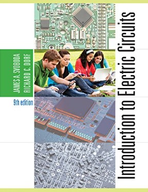Solution Found!
Consider a single-circuit element, that is, a single resistor, capacitor, or inductor
Chapter 7, Problem DP7-1(choose chapter or problem)
Consider a single-circuit element, that is, a single resistor, capacitor, or inductor. The voltage v(t) and current i(t) of the circuit element adhere to the passive convention. Consider the following cases:
(a) \(v(t)=4+2 e^{-3 t} \mathrm{~V}\) and \(i(t)=-3 e^{-3 t} \mathrm{~A}\) for t > 0
(b) \(v(t)=-3 e^{-3 t} \mathrm{~V}\) and \(i(t)=4+2 e^{-3 t} \mathrm{~A}\) for t > 0
(c) \(v(t)=4+2 e^{-3 t} \mathrm{~V}\) and \(i(t)=2+e^{-3 t} \mathrm{~A}\) for t > 0
For each case, specify the circuit element to be a capacitor, resistor, or inductor and give the value of its capacitance, resistance, or inductance.
Questions & Answers
QUESTION:
Consider a single-circuit element, that is, a single resistor, capacitor, or inductor. The voltage v(t) and current i(t) of the circuit element adhere to the passive convention. Consider the following cases:
(a) \(v(t)=4+2 e^{-3 t} \mathrm{~V}\) and \(i(t)=-3 e^{-3 t} \mathrm{~A}\) for t > 0
(b) \(v(t)=-3 e^{-3 t} \mathrm{~V}\) and \(i(t)=4+2 e^{-3 t} \mathrm{~A}\) for t > 0
(c) \(v(t)=4+2 e^{-3 t} \mathrm{~V}\) and \(i(t)=2+e^{-3 t} \mathrm{~A}\) for t > 0
For each case, specify the circuit element to be a capacitor, resistor, or inductor and give the value of its capacitance, resistance, or inductance.
ANSWER:Step 1 of 4
a)
In this case voltage and current are
